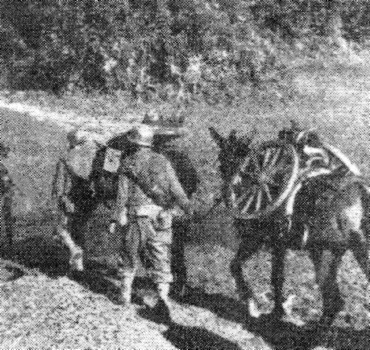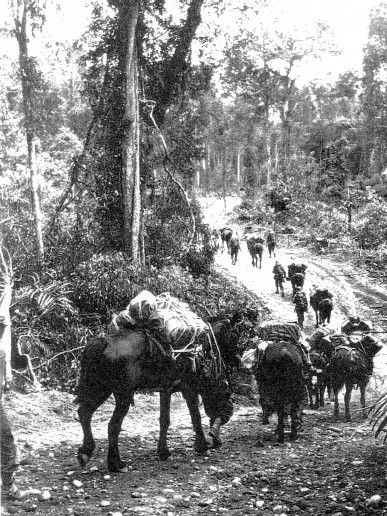|
|
|
Assigned to the airfield at Sylhet, Assam, India the Twenty-Seventh Troop Carrier Squadron was given, as one of its many assignments, the transportation of mules to and behind the enemy lines.
While other theaters had their transportation corps, weapon carriers and the likes the forces in the jungles of Burma had their mules. The sure-footed animal gave yeoman effort to the successes of the ground forces moving through the jungles of Burma and to the squadron they gave activity, aroma and urine.
Temporary stalls made with bamboo poles would be installed in the aircraft and after much persuasion the animal would be tethered down for the flight. Once the mule handlers and their animals were aboard the door to the aircraft was locked from the outside and the flight crew, using a small ladder, would enter the aircraft through a baggage compartment on the left front side of the aircraft. The entrance was directly in front of the left engine and should an emergency require bailing out one would jump directly into the path of the left propeller. Thus if the plane was in trouble it would be touch and go for the personnel.
As this mission came to an end for the Twenty-Seventh the unit received orders transferring it to the Fourteenth Air Force 'Flying Tigers" in China. The unit immediately began flying in support of the "Salween Campaign" (the invasion of Burma from China) in the drive to meet General Stilwell's forces moving into Burma from the west.
The unit was flying
drop missions at and behind the front when a radiogram arrived at base
giving orders to ground all of the squadron's C-47s. Many different
thoughts ran through the minds of the personal of the squadron but none
were accurate - or even close to being accurate. It seems that while
we were flying the mules to the war effort their urine ran down the gutters
in the metal floor and down on to the control cables to the rear of the
aircraft thus causing
them to rust and corrode. The problem showed up during inspection
on the first plane to be flown to Bangalore, India for complete overhaul.
Being the only Troop Carrier Squadron involved in the Salween Campaign
the order shut down the complete war effort in West China and East Burma
until such time that floor boards could be pulled and cables inspected
and treated with anti-corrosion chemicals and special grease applied.
This operation was especially tedious and time consuming for the engineering department and their mechanics, as they proceeded with the unthinkable task of removing all the screws by hand as no air tools were available.
With the task completed
the Twenty-Seventh returned to flying missions at once. One can imagine
the ruckus it caused at Fourteenth Air Force headquarters when General
Chennault was advised that mule urine had shut down the much needed services
of his troop carrier unit.
The mules had accomplished
what the enemy could not.
NOTE: This tale
is written from material submitted by VAN WINKLE, Lester J., "Rip".
Mules were also dropped by Para
drop but that is another tale for another time.
Harry A. Blair
Historian
Twenty-Seventh Troop Carrier Squadron
La Crosse, Wisconsin
12 April 1997
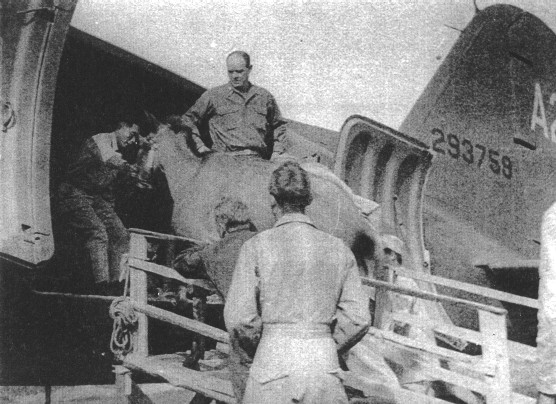
27th TCS
"ABEL TWO" AWAITS HER HIGH PRIORITY PASSENGERS
Working with animals in a combat situation in Burma might seem a little foolhardy considering the pack, the noise involved, the steep terrain to be covered. The truth is, the Mule proved he fit into the situation perfectly and all worked out very well.
"Snuffy" was a very large creature yet very gentle to work with. His packsaddle was so heavy, and he was so large, it took two men to place it on him.
Trail wise: Some animals refuse to lead well - wanting to be pulled along which proved very tiring going uphill with a heavy pack and weapon. The mule on the other hand led extremely well. Most of the time he just tagged along behind his master with a slack lead rope between them.
Sure-footedness: The terrain dictated sure-footedness in both man and beast. The trail was usually very narrow and often hacked out of the side of a hill - a hill on the up-side and steep barranca on the downhill side. He did not panic just sort of eased his back straight with the trail. Rains made some stretches of trail extremely slippery which rendered no difficulties to the animal.
Attachments: Mitchell, Robert W. writes of his "Snuffy" approaching a sharp left turn and then disappearing into the jungle. His feet were close together, his ears pointed downhill and he sort of leaned to the left and with a side paddle made the turn, skidded the rest of the way. If a mule could talk, Mitchell is certain he would have said, "whew!"
Stamina: There were times at the end of the campaign when hard marches came into play. Men and animal were exhausted. Here the mule was the stronger.
Spooky: Word had it that elephant and mule just did not mix thus if contact was eminent the mule was taken off trail, rear end to the trail, and the skinner cupped his hands as blinders on a race horse.
The foregoing was taken out of context from an article written by MITCHELL, Robert W. of the Orange Combat Team of Merrill's Marauders. In his words he has extolled the feelings of the majority of the troops fighting within the mountains and jungles of Burma. Many feel strongly they could not have met success without the mule. He was an animal for all occasions, over all terrain in the worst of weather conditions on the face of the earth.
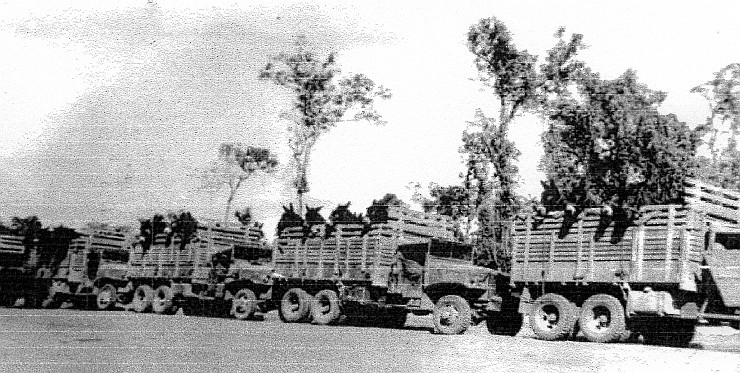
USAAF
"MULEING IN"
Yes, with the help of the 315 TH Troop Carrier Squadron, mules can fly.
To the uninitiated this may not seem like a major logistics problem but to the crews of troop carrier it was. Imagine for a moment that you are the pilot of a C-47 and your commander orders you to fly a "drop mission." The only facts needed is where and when to make the drop - a standard every day request.
This time, however, the commander's voice is different, so different that the crew’s curiosity was aroused and the question was asked, "What is the cargo?" The answer was mind boggling - "Mules" the Commander replied and walked away. Returning to their aircraft they found the statement to be accurate - mules were being put onboard. Mules had a parachute strapped to its back and you wonder if trouble is in the future as you send them out into space.
A pilot of the 315, Sweeney, Frank told of how he handled a difficult problem with the intended drop. "Since we had the mission to perform, we became interested in a few problems we thought we would never concern us as Air Force pilots. What kind of parachute should we use? Since we would be at low altitude and in rough air, how would we keep the animals quiet? How would we get a balky mule out the jump door? After being dropped, would they land safely or would they break their legs and have to be shot.
With the assist from the medics, we doped the animals, loaded them aboard and headed deep into Burma behind enemy lines. Arriving at the target we got four of the mules out of the aircraft in four passes without any trouble. Apparently the dope had worn off the fifth mule - thus he seemed to be aware of what was in his immediate future. Once his head was out the door, into the slipstream, he got panicky. He promptly dug in with all four feet and dared the crew to dislodge him. The handlers pushed and shoved as I made trip after trip over the drop zone. Each time it was the same - they could not get the animal out.
Exasperated, I turned the airplane over to the copilot and went back to see what I could do to assist. There were four handlers, the flight engineer and the radio operator standing completely baffled by the situation.
We held a conference and finally hit on an idea. It looked like what this animal needed was a little stimulus of some sort applied from behind which would make him decide that going through the door was the least of his troubles. The only thing we could think of was to build a fire under him but, of course, this would be dangerous.
There was one kind of fire that might work however. On the next pass over the target I took out my Zippo lighter, fired it up, raised the mule's tail and applied the flame to the tender spot. The mule quivered for a moment, suddenly came to life and leaped out the door like a cannon ball. Our mission was completed successfully."
The foregoing tale is assumed to have been taken from notes written by SWEENEY, Frank of the 315 TH Troop Carrier Squadron although no name is signed thereto.
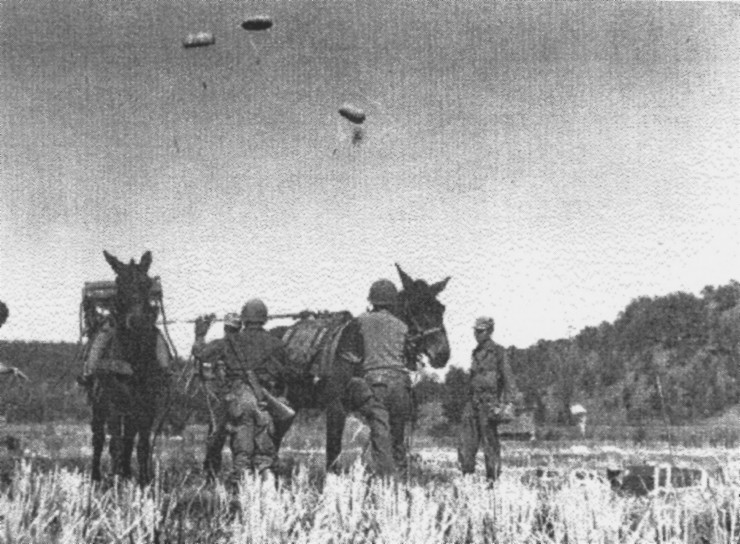
USAAF
IN THE HEAT OF BATTLE
NEAR MYITKINA 23 JANUARY 1945
